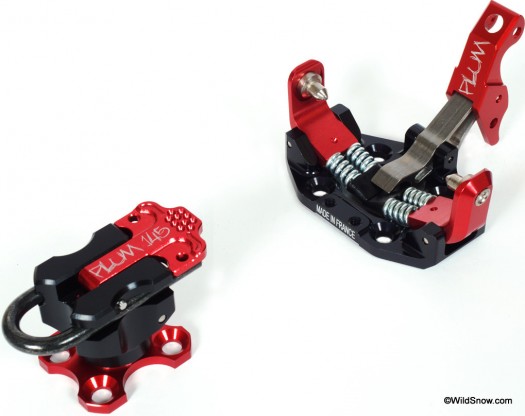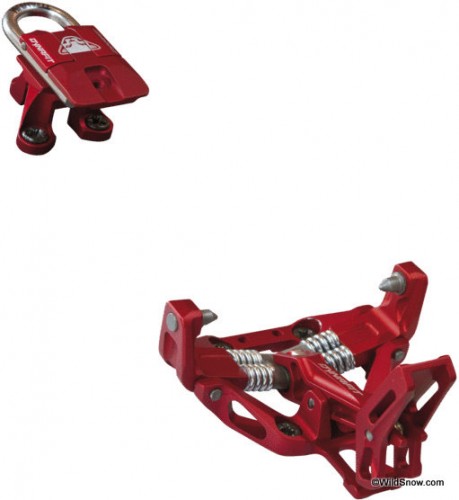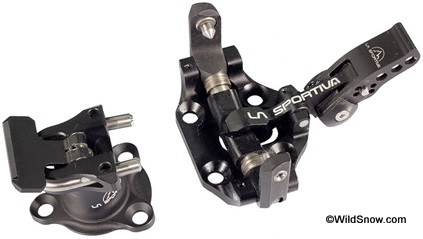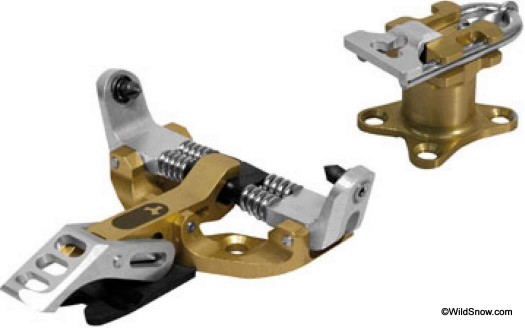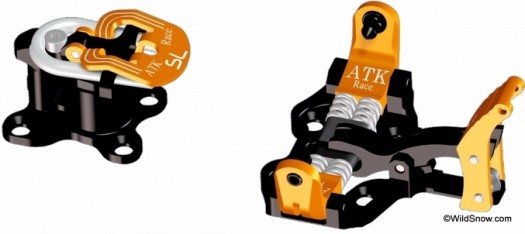Feeling weighted down by your ~two-pound Dynafit or other “tech” bindings? Maybe the time has arrived to adopt a rando race binding for your longer spring or summer backcountry skiing adventures. Or even if that’s not the case, window shopping all this lightweight exotica is great fun!
Seriously, for the 2011-12 season many different brands of rando race bindings are finally available in North America. And they’re not just for rando racing. One of my most surprising ski touring moments this summer was topping out on Shasta’s Avalanche Gulch, grateful for my ultralight Trab Duo Sinto Aero + Dynafit Speed + Dynafit TLT5 setup, only to feel like a heavy laggard when I saw some Trab race skis and rando race bindings at Red Banks. (Reports from Europe tell of numerous skiers out touring on race gear, and we generally follow those sorts of trends, so look out!)
Recognizing this trend, two “near-race” bindings are also now available for this season, with weights just barely outside the high end of this chart, yet with adjustable release settings: ATK RT which is rebranded, distributed, and fully supported by La Sportiva in North America, and new for the 2011-12 season the Dynafit Speed Superlight which combines a full-on race toe with a three-hole heel yet with two different elevator levels.
The table below summarizes all the known options for “tech” race-intended bindings. Meaning those with fixed release values. Models with North American distribution include Dynafit (although only for the Low Tech Race, not the more econo-minded Low Tech Radical), Merelli (rebranded and fully supported by La Sportiva), Plum (via a small number of retailers, plus very U.S.-friendly company-direct web sales), and Trab (via Scarpa). The discussion that follows will focus on these models plus ATK, which is one of the more popular options in Europe.
| Company | Model – w/ website link | gr. | Oz. | Price |
| ATK Race | SL World Cup | 220 | 7.8 | €415 |
| SL-R World Cup | 226 | 8.0 | €435 | |
| Colibri | C.08 / C.09 | 260 | 9.2 | €??? |
| Dynafit | Low Tech Race | 234 | 8.3 | $800 |
| Low Tech Radical | 370 | 13.1 | €375 | |
| Haereo | G1 | 240 | 8.5 | €469 |
| Kreuzspitze | Snow Crab + Trofeo | 266 | 9.4 | €350 |
| La Sportiva | RSR | 286 | 10.1 | $800 |
| Merelli | R8 Evolution | ??? | ?.? | €??? |
| PHK | Fly | 260 | 9.2 | €??? |
| Pierre Gignoux | Pack Ultimate | 120 | 4.2 | €1800 |
| Plum | Race 145 | 290 | 10.2 | $715 |
| Race 135 | 270 | 9.5 | €504 | |
| Trab | TR Race | 282 | 9.9 | $539 |
All of these models have fixed release values for both lateral and forward release, typically unspecified but typically unofficially somewhere in the high single digits. Plum is unique in offering a choice of forward release values via its 135 and 145 models, which differ in their metallic composition for the heel “fork” (i.e., the U-shaped piece that also forms the heel pins that insert into the boot interface).
All of these models also have a default mounting mode of a fixed fore-aft position. Merelli / La Sportiva and ATK offer add-on mounting plates with grooved tracks, so that the plate is first mounted to the ski, and then the binding can be secured anywhere along the track. Plum offers even more options for fore-aft adjustment: heel posts for the 135 and 145 are available with 2, 3 or 4mm offsets to avoid a remount when switching boots (or when incorrectly mounting a binding!), the 185 model (not shown in the chart) offers 40mm of adjustment with a lower heel post height to maintain the same total height as with its 135 and 145 models, and the new 165 (also not shown in the chart) offers 20mm of adjustment mountable only with a highly integrated adjustment track.
Heel units have either four or three holes, and mounting patterns vary widely. (I’ve had good luck though so far finding mounting jigs in my collection that randomly match up with different models.)
Changing between tour and ski modes is typically accomplished not via turning the heel unit, but instead by flipping a heel unit cover that either exposes the heel pins to engage them for skiing or converts them into a heel elevator for touring. This single heel elevator position is noticeably lower than the lower of the two elevator positions on a typical Dynafit or other “Tech” binding. Personally I’ve found the position on my Plum Race 135 bindings to be ideal for most skinning yet still reasonable for almost all too-flat skinning as well as for almost all too-steep skinning. (But don’t try to achieve a higher heel elevator position for the latter by rotating the heel 180 degrees then flipping the cover open all the way: although this will gain you a few more mm, these race bindings are not built to withstand the forces of such a configuration!)
For very long, extended, truly flat skinning, I’ve rotated the Plum heel unit 90 degrees for a slightly negative position (since the boot heel is resting on the ski topskin while the toe is slightly elevated). I know of at least one binding for the 2010-11 season that did not allow such a position (as any such detent was lacking for that position), but that could have changed for 2011-12, so I’ll omit the specifics. Bottom line is that if you really want such a flat/slightly-negative position, don’t just assume that any particular model can be toured without the heel elevator.
Toe units all have four holes, and all adopt the traditional Dynafit pattern (i.e., not the new Radical pattern) without the fifth center hole, except for the Dynafit models, which both use the new Radical pattern (i.e., four holes, but the two forward holes are now farther forward). Most of these models have toe levers that immediately snap into tour mode upon entry (i.e., no reaching down to pull up on the lever before skinning). Exactly what then happens when in ski mode is in flux, as apparently some models have the option to ski with the toe lever in anything but tour mode, but the latest International Ski Mountaineering Federation (“ISMF”) rules require toe release capability for the 2012-13 season. So some models might be in the process of being modified, and others [Sep 22 edit: including Plum] might offer add-on kits to allow multi-position toe levers. (On the Plum models this can also be influenced by fine-tuning of the span on the adjustable toe “wing” pincers — my 135 pair automatically go into tour mode, yet I can still twist out in ski mode. [Sep 22 edit: starting for the 2011-12 season, the pincer span is now fixed, although adjustable pincers are still available upon special request.])
For ski crampon use, the Plum, Trab, and Dynafit Low Tech Race models have removable holders (“weighing” in at about three tenths of an ounce). The ATK SL-R and Dynafit Low Tech Radical have permanently integrated crampon attachments. (Note that the Low Tech Radical simply uses the same toe as the new Speed Radical, which in turn is simply the Radical FT/ST toe piece mounted without any shims.) The ATK SL and Merelli / La Sportiva appear to have no option of attaching a ski crampon.
Weights in the chart are all spec, although based on personal experience and other sources, screw weight is most likely excluded, so plan on another ounce or so. Either way, these are all ridiculously light, almost inconceivably so for some models!
And finally, two discontinued models (not in the chart) can still be found on closeout. The first-generation Dynafit Low Tech Race combined a toe that at first glance looks like the venerable Speed (but upon closer inspection has only four mounting screws, no mounting shim, and some slightly lighter components) and a fairly typical four-hole race heel. The 2010-11 Dynafit Low Tech Lite combined the venerable Speed toe with the first-generation Low Tech Race four-hole heel (but not the newer three-hole heel as incorrectly depicted by many etailers).
(WildSnow guest blogger Jonathan Shefftz lives with his wife and daughter in Western Massachusetts, where he is a member of the Northfield Mountain and Thunderbolt / Mt Greylock ski patrols. Formerly an NCAA alpine race coach, he has broken free from his prior dependence on mechanized ascension to become far more enamored of self-propelled forms of skiing. He is an AIARE-qualified instructor, NSP avalanche instructor, and contributor to the American Avalanche Association’s The Avalanche Review. When he is not searching out elusive freshies in Southern New England or promoting the NE Rando Race Series, he works as a financial economics consultant.)
WildSnow guest blogger Jonathan Shefftz lives with his wife and daughter in Western Massachusetts, where he is a member of the Northfield Mountain and Thunderbolt (Mt. Greylock) ski patrols. Formerly an NCAA alpine race coach, he has broken free from his prior dependence on mechanized ascension to become far more enamored of self-propelled forms of skiing. He is an AIARE-qualified instructor, NSP avalanche safety instructor, and contributor to the American Avalanche Association’s The Avalanche Review. When he is not searching out elusive freshies in Southern New England, he works as a financial economics consultant.

